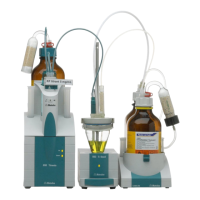
Do you have a question about the Metrohm Titrando 890 and is the answer not in the manual?
| Model | Titrando 890 |
|---|---|
| Measuring Principle | Potentiometric titration |
| Display | Graphical LCD |
| Power Supply | 100-240 V AC, 50/60 Hz |
| pH resolution | 0.001 pH |
| mV resolution | 0.1 mV |
| Temperature resolution | 0.1 °C |
| Type | Automatic Titrator |
| Connectivity | USB, Ethernet |
| Measuring range pH | 0 to 14 pH |
| Measuring range mV | -2000 to +2000 mV |
| Stirrer control | Integrated |
| Dosing devices | Up to 4 dosing devices |
| Titration Modes | MET (Monotonic Equivalence point Titration), SET (Set Endpoint Titration) |
| Dosing Rate | Adjustable |
Overview of the modular Titrando system and its peripheral devices.
Details the main characteristics and connectors of the 890 Titrando instrument.
Lists the supported titration modes, measuring modes (Ipol, Upol), and dosing commands (PREP, EMPTY, ADD).
Information regarding the manual's content, symbols, and conventions used.
Essential safety guidelines for operating the instrument safely.
Covers unpacking, checking, and selecting a suitable location for the instrument.
Instructions for connecting operating devices like Touch Control or a PC.
Guide for connecting peripheral devices using the Metrohm Serial Bus (MSB).
Instructions for connecting devices via USB interfaces to the 890 Titrando.
Information on connecting various types of sensors to the instrument.
General advice for maintaining the instrument's performance and longevity.
Troubleshooting common issues, including LED indicators and exchange unit problems.
Specific troubleshooting advice for Karl Fischer titration parameters and issues.
Details about the Remote Box and its connectors for external control.
Specifications for the polarizable electrode measuring interface, including modes Ipol and Upol.
Specifications for the instrument's internal dosing device, including cylinder volume and resolution.
Technical details regarding power supply, frequency, and consumption.
Operating, storage, and transport temperature ranges for the instrument.
Conditions defining reference operation, including temperature and humidity.
Physical dimensions (width, height, depth) and weight of the 890 Titrando.
Description of the various ports and connectors available on the instrument (USB, Controller, MSB).